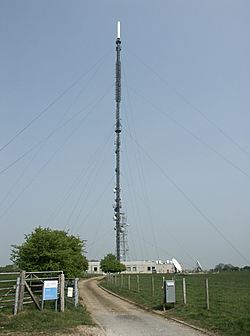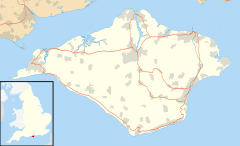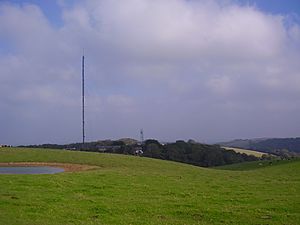Quick facts for kids
Rowridge

The Rowridge transmitting station
|
Location in Isle of Wight
|
| Mast height |
149.6 metres (491 ft) |
| Coordinates |
50°40′35″N 1°22′07″W / 50.676389°N 1.368611°W / 50.676389; -1.368611 |
| Grid reference |
SZ447865 |
| BBC region |
BBC South |
| ITV region |
Southern (1969–1981)
TVS (1982–1992)
ITV Meridian (1993–present) |
| Local TV service |
That's Solent |
The Rowridge transmitting station is a facility for FM radio and television transmission at Rowridge on the Isle of Wight in southern England.
It currently has a 172 metres (564 ft) tall guyed mast, owned and operated by Arqiva (previously National Grid Wireless). There is a smaller tower on the site belonging to British Telecom. Prior to Digital Switchover (DSO) the station broadcast with a power of 250 kW (ERP) for FM radio, 500 kW for analogue television, and 20 kW for digital television. In July 2007, Ofcom confirmed that Rowridge would remain an A Group transmitter at Digital switchover; the digital television transmission signal was then boosted to 200 kW. From March 2018 MUXES 7 & 8 moved out of the A group to channels 55 & 56 (see graph), though these are due to be turned off between 2020 and 2022.
Rowridge is one of only two main transmitters (the other is the rather smaller transmitter of Rosneath in Scotland) to broadcast its output on both horizontal and vertical polarities. Only the main 6 MUXES are transmitted in vertical polarity. The reason for this dual polarity transmission is to give a second option to those experiencing co-channel interference from transmitters on the continent.
Analogue Channel 5 was not transmitted from Rowridge but was broadcast (at 10 kW) from Fawley Power Station, with the antenna located on the main chimney. Transmissions all fitted within the A group and were horizontally polarised. On 25 March 2009, Channel 5's analogue signal was turned off from Fawley Power Station, due to the digital switchover in the neighbouring Westcountry region.
Population coverage for the main four analogue channels was about 1.75 million.
History
The station was first built to provide BBC 405-line television coverage for an area including Southampton, Portsmouth, Bournemouth, Chichester, Brighton, Winchester and Salisbury. Sites on the mainland and the Isle of Wight were considered, and three were tested by BBC Research Department. A temporary 200 ft lattice mast was built with a main antenna at 175 ft and a reserve antenna lower down. These aerials were directional to enhance the signal northwards and reduce unwanted coverage to the south.
The service opened on 12 November 1954, bringing television to the area for the first time.
A programme feed was obtained via a Post Office radio link, using refurbished equipment that provided the original picture feed for the Wenvoe Transmitter on the British Telecom Microwave Network. A site for this near Alton, Hampshire was acquired and named after a nearby pub: Golden Pot. Here the TV signal from Alexandra Palace was picked up and relayed via a one-hop 4 GHz microwave link to Rowridge. This was brought into service on 18 October 1954. Later, the microwave link ran from the Museum telephone exchange in London to Rowridge, using Golden Pot as an intermediate site.
In 1965 the UHF antenna was added making the total height of the structure 149.6 metres (491 ft). This addition allowed Rowridge to radiate the PAL 625-line transmission that allowed broadcasts in colour and eventually stereo sound, using NICAM.
On 25 March 2009, Channel 5's analogue signal was turned off from Fawley Power Station. Later on in the day, "existing digital terrestrial TV services moved to new frequencies", due to the digital switchover happening in the region in 2012.
Arqiva applied for planning permission to replace the existing 150m (492') mast with one 187m (614') high on 22 May 2009.
Channels listed by frequency
Analogue radio
Digital radio
| Frequency |
Block |
kW |
Operator |
| 225.648 MHz |
12B |
5 |
BBC National DAB |
Analogue television
12 November 1954 – 15 January 1966
| Frequency |
VHF |
kW |
Service |
| 56.75 MHz |
3 |
100 |
BBC1 |
15 January 1966 – 13 December 1969
| Frequency |
VHF |
UHF |
kW |
Service |
| 56.75 MHz |
3 |
— |
100 |
BBC1 |
| 495.25 MHz |
— |
24 |
500 |
BBC2 |
13 December 1969 – 27 December 1969
| Frequency |
VHF |
UHF |
kW |
Service |
| 56.75 MHz |
3 |
— |
100 |
BBC1 |
| 495.25 MHz |
— |
24 |
500 |
BBC2 |
| 519.25 MHz |
— |
27 |
500 |
Southern |
27 December 1969 – 4 December 1982
| Frequency |
VHF |
UHF |
kW |
Service |
| 56.75 MHz |
3 |
|
100 |
BBC1 |
| 495.25 MHz |
— |
24 |
500 |
BBC2 |
| 519.25 MHz |
— |
27 |
500 |
TVS (Southern until 1982) |
| 551.25 MHz |
— |
31 |
500 |
BBC1 |
4 December 1982 – 3 January 1985
3 January 1985 – 15 November 1998
Analogue and digital television
15 November 1998 – 31 October 2002
| Frequency |
UHF |
kW |
Service |
System |
| 471.25 MHz |
21 |
500 |
Channel 4 |
PAL System I |
| 489.833 MHz |
23- |
20 |
BBC (Mux 1) |
DVB-T |
| 495.25 MHz |
24 |
500 |
BBC Two |
PAL System I |
| 513.833 MHz |
26- |
20 |
Arqiva (Mux C) |
DVB-T |
| 519.25 MHz |
27 |
500 |
ITV1 (Meridian until 2002) |
PAL System I |
| 530.000 MHz |
28 |
20 |
Digital 3&4 (Mux 2) |
DVB-T |
| 546.000 MHz |
30 |
20 |
SDN (Mux A) |
DVB-T |
| 551.25 MHz |
31 |
500 |
BBC One |
PAL System I |
| 562.166 MHz |
32+ |
20 |
BBC (Mux B) |
DVB-T |
| 570.166 MHz |
33+ |
20 |
Arqiva (Mux D) |
DVB-T |
31 October 2002 – 24 May 2007
| Frequency |
UHF |
kW |
Service |
System |
| 471.25 MHz |
21 |
500 |
Channel 4 |
PAL System I |
| 489.833 MHz |
23- |
20 |
BBC (Mux 1) |
DVB-T |
| 495.25 MHz |
24 |
500 |
BBC Two |
PAL System I |
| 513.833 MHz |
26- |
20 |
Arqiva (Mux C) |
DVB-T |
| 519.25 MHz |
27 |
500 |
ITV1 |
PAL System I |
| 530.000 MHz |
28 |
20 |
Digital 3&4 (Mux 2) |
DVB-T |
| 546.000 MHz |
30 |
20 |
SDN (Mux A) |
DVB-T |
| 551.25 MHz |
31 |
500 |
BBC One |
PAL System I |
| 562.166 MHz |
32+ |
20 |
BBC (Mux B) |
DVB-T |
| 570.166 MHz |
33+ |
20 |
Arqiva (Mux D) |
DVB-T |
| 735.25 MHz |
54 |
2 |
Solent TV |
PAL System I |
24 May 2007 – 25 March 2009
| Frequency |
UHF |
kW |
Service |
System |
| 471.25 MHz |
21 |
500 |
Channel 4 |
PAL System I |
| 489.833 MHz |
23- |
20 |
BBC (Mux 1) |
DVB-T |
| 495.25 MHz |
24 |
500 |
BBC Two |
PAL System I |
| 513.833 MHz |
26- |
20 |
Arqiva (Mux C) |
DVB-T |
| 519.25 MHz |
27 |
500 |
ITV1 |
PAL System I |
| 530.000 MHz |
28 |
20 |
Digital 3&4 (Mux 2) |
DVB-T |
| 546.000 MHz |
30 |
20 |
SDN (Mux A) |
DVB-T |
| 551.25 MHz |
31 |
500 |
BBC One |
PAL System I |
| 562.166 MHz |
32+ |
20 |
BBC (Mux B) |
DVB-T |
| 570.166 MHz |
33+ |
20 |
Arqiva (Mux D) |
DVB-T |
25 March 2009 – 7 March 2012
| Frequency |
UHF |
kW |
Service |
System |
| 471.25 MHz |
21 |
500 |
Channel 4 |
PAL System I |
| 495.25 MHz |
24 |
500 |
BBC Two |
PAL System I |
| 519.25 MHz |
27 |
500 |
ITV1 |
PAL System I |
| 530.166 MHz |
28+ |
20 |
BBC (Mux B) |
DVB-T |
| 545.833 MHz |
30- |
20 |
SDN (Mux A) |
DVB-T |
| 551.25 MHz |
31 |
500 |
BBC One |
PAL System I |
| 562.166 MHz |
32+ |
20 |
Digital 3&4 (Mux 2) |
DVB-T |
| 570.166 MHz |
33+ |
20 |
Arqiva (Mux D) |
DVB-T |
| 578.000 MHz |
34 |
20 |
BBC (Mux 1) |
DVB-T |
| 602.166 MHz |
37+ |
20 |
Arqiva (Mux C) |
DVB-T |
7 March 2012 – 21 March 2012
| Frequency |
UHF |
kW |
Service |
System |
| H |
V |
| 471.25 MHz |
21 |
500 |
— |
Channel 4 |
PAL System I |
| 498.000 MHz |
24 |
200 |
200 |
BBC A |
DVB-T |
| 519.25 MHz |
27 |
500 |
— |
ITV1 |
PAL System I |
| 530.166 MHz |
28+ |
20 |
— |
BBC (Mux B) |
DVB-T |
| 545.833 MHz |
30- |
20 |
— |
SDN (Mux A) |
DVB-T |
| 551.25 MHz |
31 |
500 |
— |
BBC One |
PAL System I |
| 562.166 MHz |
32+ |
20 |
— |
Digital 3&4 (Mux 2) |
DVB-T |
| 570.166 MHz |
33+ |
20 |
— |
Arqiva (Mux D) |
DVB-T |
| 602.166 MHz |
37+ |
20 |
— |
Arqiva (Mux C) |
DVB-T |
Digital television
21 March 2012 – 18 April 2012
| Frequency |
UHF |
kW |
Operator |
System |
| H |
V |
| 474.166 MHz |
21+ |
200 |
200 |
BBC B |
DVB-T2 |
| 498.000 MHz |
24 |
200 |
200 |
BBC A |
DVB-T |
| 522.000 MHz |
27 |
200 |
200 |
Digital 3&4 |
DVB-T |
| 545.833 MHz |
30- |
50 |
— |
SDN |
DVB-T |
| 570.166 MHz |
33+ |
50 |
— |
Arqiva B |
DVB-T |
| 602.166 MHz |
37+ |
50 |
— |
Arqiva A |
DVB-T |
18 April 2012 – present
The commercial multiplexes were situated on their pre-DSO frequencies until 18 April 2012, when they started transmitting at vertical polarisation.
| Frequency |
UHF |
kW |
Operator |
System |
| H |
V |
| 474.166 MHz |
21+ |
200 |
200 |
BBC B |
DVB-T2 |
| 482.166 MHz |
22+ |
50 |
200 |
Arqiva A |
DVB-T |
| 498.000 MHz |
24 |
200 |
200 |
BBC A |
DVB-T |
| 506.000 MHz |
25 |
50 |
200 |
SDN |
DVB-T |
| 522.000 MHz |
27 |
200 |
200 |
Digital 3&4 |
DVB-T |
| 530.000 MHz |
28 |
50 |
200 |
Arqiva B |
DVB-T |
| 602.000 MHz |
37 |
10 |
- |
Local Multiplex |
DVB-T |




